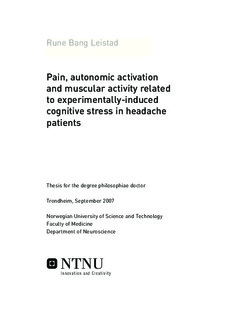| dc.contributor.advisor | Sand, Trond | nb_NO |
| dc.contributor.advisor | Stovner, Lars Jacob | nb_NO |
| dc.contributor.advisor | White, Linda | nb_NO |
| dc.contributor.advisor | Westgaard, Rolf H. | nb_NO |
| dc.contributor.author | Leistad, Rune Bang | nb_NO |
| dc.date.accessioned | 2014-12-19T14:16:35Z | |
| dc.date.available | 2014-12-19T14:16:35Z | |
| dc.date.created | 2007-09-17 | nb_NO |
| dc.date.issued | 2007 | nb_NO |
| dc.identifier | 122692 | nb_NO |
| dc.identifier.isbn | 978-82-471-4122-9 | nb_NO |
| dc.identifier.uri | http://hdl.handle.net/11250/263097 | |
| dc.description.abstract | Background and objectives
Stress is in several studies mentioned as the most frequent trigger of headache. Nevertheless, the exact mechanisms by which stress induces headache is poorly understood and relatively few studies with rigorous scientific methods mimicking real life settings have been performed. In the present study an experimental model was used to study muscular, cardiovascular and biochemical responses to cognitive low-grade stress and investigate relationships between these responses and pain in the head and shoulder/neck areas.
Methods
This thesis is based on data recorded during and after a stress test in healthy controls and patients with migraine or tension-type headache (TTH). The stress test consisted of a two-choice reaction time test designed to imitate real-life working conditions in a stressful office environment. The stress test lasted for 60 minutes and was followed by 30 minutes of relaxation. We recorded pain and surface electromyographic (EMG) activity in the trapezius, splenius, temporalis and frontalis muscles, in addition to blood pressure (BP), heart rate (HR), skin blood flow (BF) in the fingers as well as noradrenaline, adrenaline and cortisol levels in blood sampled before and after the stress test.
Results
The main findings were higher pain responses in the temporalis and frontalis areas (with similar trends for trapezius and splenius) and more potentiation of pain during the test when comparing TTH patients with controls. Migraine patients developed more pain in the splenius and temporalis areas than controls. TTH patients had a more generalised pain increase in all areas, while pain increase was more regional (more pain in the neck/shoulder compared to the head) in migraine. TTH patients had delayed pain recovery in all areas compared to controls, while migraine had delayed pain recovery in the trapezius and temporalis areas. The temporalis EMG response was increased in migraineurs compared to controls, but there were no other differences in EMG responses between the diagnostic groups, and EMG responses were not correlated with pain responses. TTH patients had delayed EMG recovery in the trapezius compared to controls and migraineurs.
Cardiovascular responses to cognitive stress in migraine patients did not differ from those in control subjects. In TTH patients, a lack of HR-adaptation during stress was found and a trend towards a delayed systolic BP response during stress was also observed. Finger BF recovery was delayed after stress and stress-induced pain was associated with less vasoconstriction in TTH during recovery.
TTH patients had significantly less cortisol change to stress than controls and migraineurs, which has to our knowledge not been reported before. Migraineurs had lower noradrenaline levels in blood platelets compared to controls, and pain responses correlated negatively with noradrenaline levels in migraineurs.
Conclusions
Our results suggest that both patients with migraine and TTH respond differently to stress compared to controls. The increased pain responses and potentiation of pain observed in TTH support the hypothesis that central sensitization is important in these patients, and together with EMG recovery data suggest that TTH patients may be sensitized both in nociceptive and somatomotor neural pathways. Data on migraineurs points towards more limited regional pain sensitization and suggests that neck pain may be a trigger or prodrome to stress-induced migraine attacks in some patients. Surfacedetectable muscular activity during stress did not appear to be causal for pain in migraine or TTH patients.
Based on pain, cardiovascular and cortisol data we hypothesize that TTH patients may have different stress adaptive mechanisms than controls and migraineurs, involving regulation of the cardiovascular system, the hypothalamus-pituitary-adrenocortical axis and pain control systems.
For migraineurs, the lower noradrenaline levels and the inverse correlation found between noradrenaline and pain responses suggests that the sympathoneural response to stress appears to be closely linked with stress-induced pain in these patients. | nb_NO |
| dc.language | eng | nb_NO |
| dc.publisher | Det medisinske fakultet | nb_NO |
| dc.relation.ispartofseries | Doktoravhandlinger ved NTNU, 1503-8181; 2007:186 | nb_NO |
| dc.relation.haspart | Leistad, Rune Bang; Sand, Trond; Westgaard, Rolf H.; Nilsen, Kristian Bernhard; Stovner, Lars Jacob. Stress-induced pain and muscle activity in patients with migraine and tension-type headache. Cephalalgia. 26(1): 64-73, 2006. | nb_NO |
| dc.relation.haspart | Leistad, Rune Bang; Sand, Trond; Nilsen, Kristian Bernhard; Westgaard, Rolf H.; Stovner, Lars Jacob. Cardiovascular responses to cognitive stress in patients with migraine and tension-type headache. BMC Neurology. 7(1): 23, 2007. | nb_NO |
| dc.relation.haspart | Leistad, Rune Bang; Stovner, Lars Jacob; White, Linda R.; Nilsen, Kristian Bernhard; Westgaard, Rolf H.; Sand, Trond. Noradrenaline and cortisol changes to low-grade cognitive stress differ in migraine and tension-type headache. J Headache Pain. 8: 71-76, 2007. | nb_NO |
| dc.subject | MEDICINE: Morphology, cell biology, pathology: Cell biology: Neuroscience | en_GB |
| dc.title | Pain, autonomic activation and muscular activation to experimentally-induced cognitive stress in headache patients | nb_NO |
| dc.type | Doctoral thesis | nb_NO |
| dc.source.pagenumber | 135 | nb_NO |
| dc.contributor.department | Norges teknisk-naturvitenskapelige universitet, Det medisinske fakultet | nb_NO |
| dc.description.degree | PhD i nevrovitenskap | nb_NO |
| dc.description.degree | PhD in Neuroscience | en_GB |
